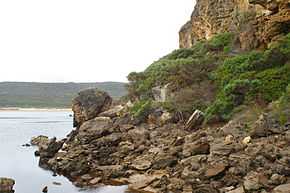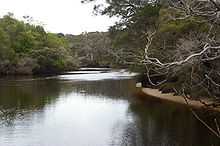Donnelly River (Western Australia)
| Donnelly River | |
|---|---|
 Limestone cliff near the mouth of the river | |
| Origin | between Bridgetown and Manjimup |
| Mouth | Southern Ocean |
| Basin countries | Australia |
| Length | 151 kilometres (94 mi)[1] |
| Mouth elevation | sea level |
| Avg. discharge | 331 GL/yr [2] |
| Basin area | 1,725 square kilometres (666 sq mi)[3] |
The Donnelly River is a river in the South West of Western Australia.
The main tributaries of the Donnelly River are Barlee Brook and Carey Brook.
The first European to sight the river was Lieutenant William Preston in 1831. The river was named by James Stirling, the Governor of Western Australia, in the 1830s after a friend of his family, Admiral Sir Ross Donnelly.[4] The river runs primarily through state forest reserves, although 43 land-holdings do have river frontage. The clearing of the catchment area is estimated at 15–20% with the land mostly being used for perennial horticulture, dairy and grazing.
Fauna
The Donnelly is one of the few catchments left in the state that contains all of the region's endemic freshwater fishes. Native freshwater species include salamanderfish (Lepidogalaxias salamandroides), freshwater cobbler (Tandanus bostocki), western minnow (Galaxias occidentalis), western mud minnow (Galaxiella munda), black-stripe minnow (Galaxiella nigrostriata), western pygmy perch (Nannoperca vittata), Balston's pygmy perch (Nannatherina balstoni), nightfish (Bostockia porosa), and pouched lamprey (Geotria australis).
Many estuarine fish are found close to the mouth of the river, these include black bream (Acanthopagrus butcheri), flathead mullet (Mugil cephalus), yellow-eye mullet (Aldrichetta forsteri), Australian herring (Arripis georgianus), and freshwater cobbler (Tandanus bostocki).[5]
Several species have been introduced into the river, including eastern mosquitofish (Gambusia holbrooki), European perch (Perca fluviatilis), and rainbow trout (Oncorhynchus mykiss). The latter is the most common, being specifically introduced for angling purposes, with over 500,000 being stocked into the system between 1999 and 2004.[6]
Flora

The river originates in the an area of open jarrah-marri forest between Bridgetown and Manjimup. The area contains an understorey composed of such species as bull banksia (Banksia grandis), sheoak (Allocasuarina fraseriana), snottygobble (Persoonia longifolia), prickly moses (Acacia pulchella), zamia palm (Macrozamia reidlei), balga (Xanthorrhoea preissii), and graceful grass tree (Xanthorrhoea gracilis).
The river then flows through a large area of tall karri forests. The understorey includes karri sheoak (Allocasuarina decussata), oakleaf thomasia (Thomasia quercifolia) and Western Australian peppermint (Agonis flexuosa).
Toward the coast the floral composition changes as the soils change to swampy flats and consolidated dunes. Species such as stout paperbark (Melaleuca preissiana), swamp paperbark (Melaleuca rhaphiophylla), yate (Eucalyptus cornuta), Warren River cedar (Taxandria juniperina), wonnich (Callistachys lanceolata), and various banksias start to dominate.
References
| Wikimedia Commons has media related to Donnelly River. |
- ↑ "Donnelly River Action Plan". 2006. Retrieved 10 November 2008.
- ↑ "Context Report on Southwest Water Resources". 2008. Retrieved 10 November 2008.
- ↑ "South West Water Resources - Regional Overview". 2007. Retrieved 10 November 2008.
- ↑ Western Australian Land Information Authority. "History of river names". Retrieved 3 September 2011.
- ↑ "Fish Fauna of the Donnelly River, Western Australia". 2006. Retrieved 10 November 2008.
- ↑ "Donnelly River Action Plan". 2006. Retrieved 10 November 2008.
Coordinates: 34°29′S 115°40′E / 34.483°S 115.667°E